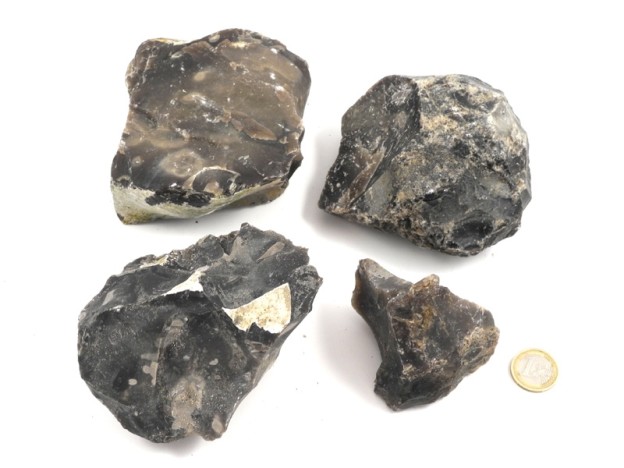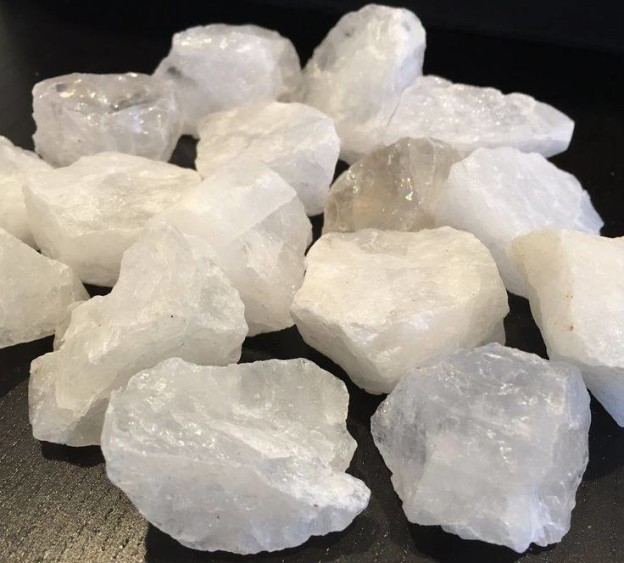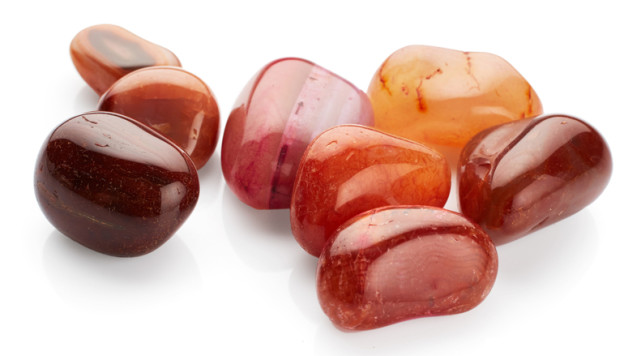Carnelian – orange, red-orange color chalcedony. Chalcedony consist of thin quartz crystals and have a fibrous structure. Orange-red and orange-yellow-pink chalcedony are called cornelian. Dark specimens of carnelian brown-red color are called carneols.
Carnelian is a stone with weak radioactive properties, which requires a golden frame. It is often called the July gem. He gives his owners love, conjugal happiness, health, courage. In ancient Egypt, carnal and ritual ornaments were made from carnelian, which were dedicated to the goddess Isis. The symbol of the goddess Isis resembles the shape of a three-leafed clover – it was carved in carnelian – on the clasps, on the rings, and thus asked the great goddess, the “mother of the gods”, for protection and after death.
Red carnelian was considered the stone of the martyr Bartholomew.
In the Middle Ages, carnelian ornaments were very popular, because at that time it was believed that this beautiful stone could defeat black magic, protect from ill-will, contribute to secrecy, give the owner courage, reconcile quarrels, keep away from evil spells and lightning. It was also believed that carnelian intensifies the sense of touch and protects against the squandering of vitality.
Carnelian contributes to the treatment of fever and nervous diseases, strengthens the teeth, regulates menstruation, has bactericidal properties.
Carnelian necklace is recommended to be worn for Graves’ disease. If you put cornelian on the eyelids of closed eyes, it helps with headache. Women kept carnelian in their mouths during childbirth.
Carnelian, worn in a suspended form (necklace, beads, rosary, etc.), is capable of increasing anger. Therefore, it is recommended to wear it in the rings – then it calms the heartbeat, contributes to the favorable response of another person to this or that request. In ancient times, carnelian was divided into “male” and “female”. Reddish carnelian was considered “male”, and orange-yellow – “female”.
Carnelian helps the digestion of food, the search for a way out of any life situations, is useful for the circulatory system, protects against infections, regulates the functioning of the thyroid gland.
The name “cornelian” came from the Greek word sardolith – a stone from Sard. Other names of the mineral and its varieties: blood agate, linkurus, carneol, sard.
The name of the stone comes from the Old Russian “image as heart”. This collective name of chalcedony (a cryptocrystalline variety of silica) is a sardar (from Sardis – the name of the capital of the Lydian kingdom, located near the Aegean coast of modern Turkey), carnelian (from the Latin cornum – dogwood), linkurus.
Carnelian, sardine, carnelian – one of the few names of precious stones, reached us through the millennium, almost unchanged. The oldest obsolete synonyms of the name “carnelian” were “akiq”, “vaklar” and “demion”.
Physical properties :
- a) Consists of a cryptocrystalline variety of silica, naturally colored with hydroxides and iron oxides in chestnut, brown-red (starter); red, orange-red (carnelian); orange-yellow and yellow (lenturium) shades,
- b) hardness of carnelian – 6.5-7,
- c) density – 2.6 g / cm3,
- d) the degree of transparency – translucent to transparent.
Features of education. Carnelian was formed as a result of ancient volcanic processes in the bubbles (tonsils) of lava flows and vent structures of the volcanoes, where it is found together with agate and other colored varieties of chalcedony. But its rich color, as many geologists believe, it acquires already on the surface, after the destruction of its volcanic rocks, including, under the influence of sunlight.
The deposit of the best carnelians in Russia is Eastern Siberia: the basin of the Zeya River (Amur Region), Yakutia, Chukotka, Buryatia, southeast of the Chita Region; from foreign deposits, it is worth mentioning India (the Deccan Highlands, Gujarat), Mongolia, the USA (Montana state), the island of Madagascar, Uruguay and Brazil.
Application. The first products of carnelian (the oldest tools) were encountered during excavations of paleolithic man sites (800-60 thousand years BC). As a material for the manufacture of jewelry, amulets, talismans and cult objects, carnelian has been used since the early Neolithic (18 thousand years BC).
The most popular of this remarkable stone was in Ancient Greece, Mesopotamia, the Middle East, in Russia and in medieval Europe. It was valued much higher than many of the precious stones and metals are known at that time, for example, in the 4th century AD. carnelian ranked fifth in value in the row: diamond, pearl, emerald, noble opal, carnelian, red carbuncles (spinel, ruby, garnet) and then gold, silver, sapphire, and topaz.
From it was made amulets, rings, other jewelry, carved prints, cameos, intaglio, figurines, cups, crosses. Carnelian – a traditional material for the manufacture of jewelry. Carnelian, in general, was loved by many great and famous people: the history included the suspension and a favorite vessel of carnelian with shadows for the ages of Queen Cleopatra (69-30 BC), belt buckle decorated with carnelian “Stunner of the Universe” warrior Tamerlane , the seal of the last Hetman of Ukraine, Kirill Razumovsky, the ring-mascot of Byron, according to the legend presented to him in Greece by the gypsy Khatadzhe (in fact he was presented to the poet by his friend Edston, supposedly as a token of gratitude for saving his life).
In ancient Egypt, carnelian likened to the “sunset in the stone”, was considered the stone of the goddess Isis (the mother of all gods), able to bring wealth and glory, to ensure a tranquil descent into the next world and a sweet stay in it. According to J. Kuntz, the 156th chapter of the Egyptian “Book of the Dead” begins with these words: “The head of the buckle of cornelian placed on the neck of the dead.” Isis blood, Isis virtue, the magical power of Isis, the magical power of the Eye guarding this Great (deceased ) – they will turn away any evil that threatens him. “
Medicinal properties
As a remedy carnelian is known since ancient times. It was used by Egyptian healers in diseases of the nervous system. In Europe, carnelian, worn to powder, diluted with wine and taken as a medicine for diseases such as arrhythmia, hearing impairment, hypertension, headache. It is believed that the powder from this stone can improve blood circulation, stop internal bleeding, heal kidney diseases. Modern with therapists suggest that this stone should be worn on the body to get rid of ulcers, tumors, and with a migraine, small, polished pieces should be placed on closed eyelids.
Carnelian affects the frontal chakra.
Magic properties
In many countries of the world, carnelian personifies love, faith, family happiness. In Ancient Rus this stone was considered a love talisman, and in Ancient Greece, from it wedding gems were cut out. In the countries of the East, the cornelian was used to make amulets capable of protecting their masters from evil spells, envy, evil eye and dashing people. Carnelian is the stone of people born under the signs of the Virgin and Gemini. Virgo he helps to cope with uncontrollable anger, Gemini gives the opportunity to discover hidden talents and develop them.



